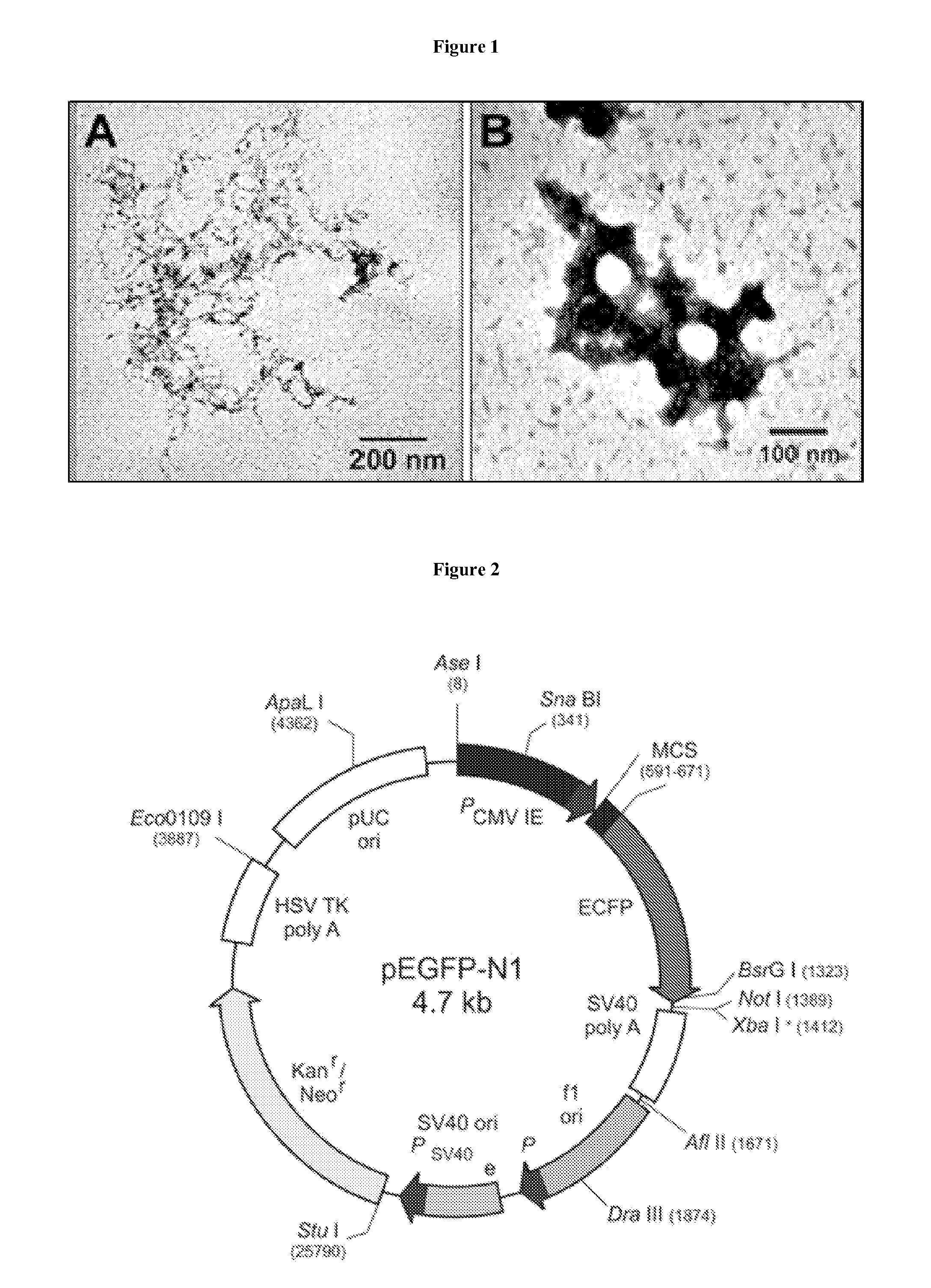Nts-polyplex nanoparticles system for gene therapy of cancer
a nanoparticle and polymer technology, applied in the direction of peptides, peptides/protein ingredients, transferases, etc., can solve the problems of high risk of mesothelioma being resistant to treatment, and working directly with asbestos or asbestos products, etc., to achieve the effect of narrowing the specificity of the strategy
- Summary
- Abstract
- Description
- Claims
- Application Information
AI Technical Summary
Benefits of technology
Problems solved by technology
Method used
Image
Examples
example 1
Synthesis of NTS-vector: NTS-(PF)-SPDP-PLL
[0104]For the synthesis of the NTS-vector we used following peptides: NTS (sequence ELYENKPRRPYIL), purity >90% and 1,672 Da molecular mass (MM) (Sigma, St. Louis Mo., USA), and PF (sequence GLFEAIAEFIEGGWEGLIEGSAKKK), purity 96% and 2,695 Da of MM (Synpep Corp., Dublin, Calif., USA.) Both peptides were simultaneously binded to PLL of MM ranged from 25,600 to 47,900 (average 36,750 Da) (Sigma, St. Louis Mo., USA.) This has 251 potentially reactive amino groups. As biofunctional cross-linker we used N-succinimidyl 6-3[3-(2-pyridyldithio) propionamide] hexanoate (LC-SPDP; MM 452.52; Cat. 21651; Pierce Chemical Co, Rockford, Ill., USA).
[0105]The NTS-vector synthesis is a process that comprises five sequential steps performed at room temperature: 1) formation of PLL-SPDP conjugate; 2) formation of PLL-SPDP-SH conjugate; 3) formation of NTS-SPDP conjugate; 4) formation of PFSPDP; and 5) formation of NTS-vector [NTS-(PF)-SPDP-PLL] from the conjuga...
example 2
Formation of PLL-SPDP-SH Conjugate
[0106]25 mg of PLL were dissolved in 2 mL of a phosphate buffer solution (PBS: 17.42 mM de Na2HPO4, 2.58 mM KH2HPO4, 150 mM NaCl, 1 mM EDTA, pH 7.2). This was mixed with 7.5 mg of LC-SPDP dissolved previously in 30 μL of dimethyl sulfoxide (DMSO). The mixture of PLL with LC-SPDP was incubated for 30 minutes under constant stirring. After this period, the resulting conjugate (PLL-SPDP) was purified on a Econo-Pac 10DG column (Bio-Rad Laboratories, Hercules, Calif., USA) equilibrated with PBS. We collected fractions of 1 mL. An aliquot of 3 μl was taken from each fraction, and it was read in a NanoDrop spectrophotometer (NanoDrop Technologies ND—1000) to determine its absorbance at 215 and 280 nm.
[0107]Econo-Pac 10DG column allows the elution of <6,000 Da molecules; thus, the PLL-SPDP conjugate (52,043 Da) is obtained in the first peak (3-7 mL), while free SPDP (425.5 Da) and N-hydroxysuccinimide (114 Da) released as a reaction product elute in the se...
example 3
Formation of NT-SPDP Conjugate
[0110]10 mg of NTS were dissolved in 2 mL of PBS and mixed with 5 mg of LC-SPDP dissolved previously in 30 μL of DMSO. The reaction mixture was incubated for 30 minutes under constant stirring. After incubation, the NTS-SPDP conjugate was purified on Sephadex G-10 column (Pharmacia Fine Chemicals AB, Uppsala, Sweden) equilibrated with PBS. Fractions of 0.1 mL were collected; 3 μl aliquots of each fraction were read on NanoDrop to determine their absorbance at 215 and 280 nm. Sephadex G-10 has a circumvention ability of <700 Da; therefore, the NTS-SPDP conjugate (2,419 Da) eluted in the first peak volume (3.5-8.4 mL). Fractions corresponding to the first peak were collected and concentrated at 1 mL.
PUM
| Property | Measurement | Unit |
|---|---|---|
| diameter | aaaaa | aaaaa |
| time | aaaaa | aaaaa |
| molecular mass | aaaaa | aaaaa |
Abstract
Description
Claims
Application Information
 Login to View More
Login to View More - R&D
- Intellectual Property
- Life Sciences
- Materials
- Tech Scout
- Unparalleled Data Quality
- Higher Quality Content
- 60% Fewer Hallucinations
Browse by: Latest US Patents, China's latest patents, Technical Efficacy Thesaurus, Application Domain, Technology Topic, Popular Technical Reports.
© 2025 PatSnap. All rights reserved.Legal|Privacy policy|Modern Slavery Act Transparency Statement|Sitemap|About US| Contact US: help@patsnap.com



